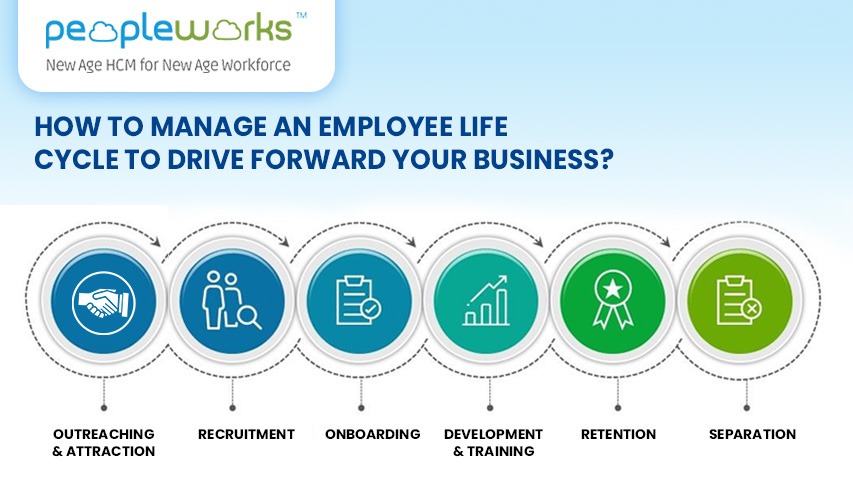A positive attitude within your organization should be to develop and promote an employee experience that contributes to retention, productivity, and elevated employee engagement. Rather than approaching employee engagement as a one-time occurrence when morale is down, the Employee Lifecycle Management views it as a planned activity that is integrated into the course of every employee in the company.
Employee life cycle identifies the various stages and periods that an employee goes through when working for a company. HR’s function during ELM is crucial, and it starts even before the employee is hired. outreach & attraction, recruitment, onboarding, development and training, retention, and separation are the six stages of ELM, according to HR. The process involves how the company introduces itself, the way it communicates with candidates, how it invites people into the organization and facilitates their personal and professional growth within the organization.
With the aid of employee lifecycle management, businesses can look at all of the ways they can improve their employees’ time at the company. Providing a rewarding work environment for your employees has many advantages, including increased staff retention, greater employee satisfaction, and high work productivity. Let’s look at each stage in greater depth to see how employee life cycle management can boost employee engagement.
OUTREACHING & ATTRACTION
Your business will struggle if it cannot attract and retain great talent, no matter how creative or good your product or service is. As a result, the attraction stage is one of the most important aspects of any company’s growth strategy. There are some main tips you should follow to create a great employer brand and excel in the employee attraction stage using LCM:
– Increase brand recognition
– Establish a reputation for having a great culture
– Have enticing benefits and compensation
RECRUITMENT
The best recruiting strategies include a positive applicant experience, encourage collaborative selection based on relevant requirements and procedures, and provide actionable data that can be used to enhance hiring outcomes over time. Here are a few key tips to use in your recruiting stage if you want to be successful in attracting the right talent for your team:
– Be specific about who and what you’re looking for
– Execute an interview process. Determine how many rounds of interviews you’ll conduct internally
– Involve your existing employees
– Experiment with different recruiting platforms
ONBOARDING
The onboarding cycle is crucial for rapidly and smoothly acclimating your new employees to the organizational atmosphere and performance aspects of their new job. New workers cover more in-depth aspects of their job during the onboarding period, identifying the attitudes, experience, abilities, and behaviors needed to work efficiently within the organization. Here are some main approaches you can use to make the onboarding stage of your company’s employee life cycle go as smoothly as possible for everyone involved, leveraging employee onboarding software like PeopleWorks
● Be specific about your expectations.
● Talk about the company’s goals and principles.
● Make daily follow-ups
● Have a job description
DEVELOPMENT & TRAINING
During this time, you can begin to consistently promote professional development among your staff, which will help them improve their skills and provide them with a potential career path within the business. The following are some key recommendations for improving the professional development stage of your employee life cycle:
● Encourage your team members to take charge of their development.
● Reward personnel who train on their schedule
● Collaboratively evaluate knowledge and skills
● Promote external learning
RETENTION
In this phase, the company culture has a significant impact. If your company’s culture is bad, you’ll inevitably have a high employee turnover rate, which means you’ll have to replace employees regularly. Improving the retention stage is a perfect way to mitigate this risk and inspire the team’s career paths to be longer and more rewarding. Here are some pointers to help you keep your main employees:
● Recognize the factors that drive your employees’ motivation
● Communicate the organization’s mission and team goals freely
● Develop positive relationships with your coworkers
● Request employee feedback and monitor team morale regularly
SEPARATION
The last phase of an employee life cycle. It’s important to treat the separation process with the same degree of urgency as the onboarding process and to approach it with the same level of strategy. If one of the team members leaves, it affects the rest of the team. It is the role of the company’s manager and HR experts to ensure that the departing employee leaves without causing significant disruption. Here are a few key ideas for mitigating the disruption’s effects:
● Recognize the reasons for the separation.
● Request candid reviews.
● Remind the team to stay focused on the future.
● Try to be hopeful.
Employee Lifecycle Management must be prioritized if you want to have the best employee experience for your employees. While this structure is prone to modification, it will provide the workforce with a clear sequence of steps. With the right tools, the management and HR teams will be able to evaluate data and detect any problems or flaws, resulting in changes across the board. If you want to learn more about it, feel free to contact us.
